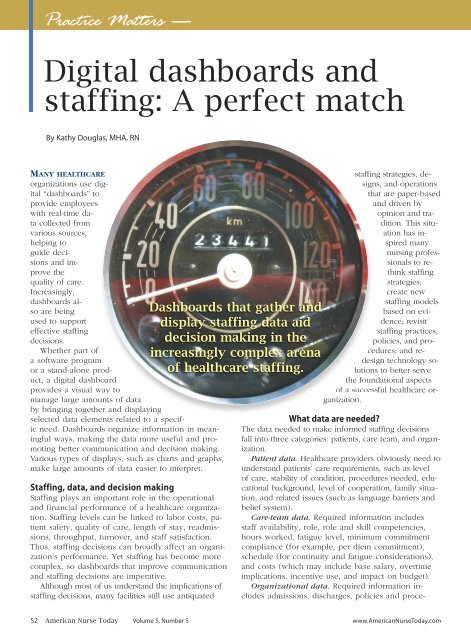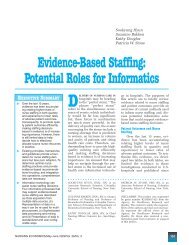Digital dashboards and staffing: A perfect match - Myla Wagner ...
Digital dashboards and staffing: A perfect match - Myla Wagner ...
Digital dashboards and staffing: A perfect match - Myla Wagner ...
You also want an ePaper? Increase the reach of your titles
YUMPU automatically turns print PDFs into web optimized ePapers that Google loves.
Practice Matters —<br />
<strong>Digital</strong> <strong>dashboards</strong> <strong>and</strong><br />
<strong>staffing</strong>: A <strong>perfect</strong> <strong>match</strong><br />
By Kathy Douglas, MHA, RN<br />
MANY HEALTHCARE<br />
organizations use digital<br />
“<strong>dashboards</strong>” to<br />
provide employees<br />
with real-time data<br />
collected from<br />
various sources,<br />
helping to<br />
guide decisions<br />
<strong>and</strong> improve<br />
the<br />
quality of care.<br />
Increasingly,<br />
<strong>dashboards</strong> also<br />
are being<br />
used to support<br />
effective <strong>staffing</strong><br />
decisions.<br />
Whether part of<br />
a software program<br />
or a st<strong>and</strong>-alone product,<br />
a digital dashboard<br />
provides a visual way to<br />
manage large amounts of data<br />
by bringing together <strong>and</strong> displaying<br />
selected data elements related to a specific<br />
need. Dashboards organize information in meaningful<br />
ways, making the data more useful <strong>and</strong> promoting<br />
better communication <strong>and</strong> decision making.<br />
Various types of displays, such as charts <strong>and</strong> graphs,<br />
make large amounts of data easier to interpret.<br />
Staffing, data, <strong>and</strong> decision making<br />
Staffing plays an important role in the operational<br />
<strong>and</strong> financial performance of a healthcare organization.<br />
Staffing levels can be linked to labor costs, patient<br />
safety, quality of care, length of stay, readmissions,<br />
throughput, turnover, <strong>and</strong> staff satisfaction.<br />
Thus, <strong>staffing</strong> decisions can broadly affect an organization’s<br />
performance. Yet <strong>staffing</strong> has become more<br />
complex, so <strong>dashboards</strong> that improve communication<br />
<strong>and</strong> <strong>staffing</strong> decisions are imperative.<br />
Although most of us underst<strong>and</strong> the implications of<br />
<strong>staffing</strong> decisions, many facilities still use antiquated<br />
Dashboards that gather <strong>and</strong><br />
display <strong>staffing</strong> data aid<br />
decision making in the<br />
increasingly complex arena<br />
of healthcare <strong>staffing</strong>.<br />
<strong>staffing</strong> strategies, designs,<br />
<strong>and</strong> operations<br />
that are paper-based<br />
<strong>and</strong> driven by<br />
opinion <strong>and</strong> tradition.<br />
This situation<br />
has inspired<br />
many<br />
nursing professionals<br />
to rethink<br />
<strong>staffing</strong><br />
strategies;<br />
create new<br />
<strong>staffing</strong> models<br />
based on evidence;<br />
revisit<br />
<strong>staffing</strong> practices,<br />
policies, <strong>and</strong> procedures;<br />
<strong>and</strong> redesign<br />
technology solutions<br />
to better serve<br />
the foundational aspects<br />
of a successful healthcare organization.<br />
What data are needed?<br />
The data needed to make informed <strong>staffing</strong> decisions<br />
fall into three categories: patients, care team, <strong>and</strong> organization.<br />
Patient data. Healthcare providers obviously need to<br />
underst<strong>and</strong> patients’ care requirements, such as level<br />
of care, stability of condition, procedures needed, educational<br />
background, level of cooperation, family situation,<br />
<strong>and</strong> related issues (such as language barriers <strong>and</strong><br />
belief system).<br />
Care-team data. Required information includes<br />
staff availability, role, role <strong>and</strong> skill competencies,<br />
hours worked, fatigue level, minimum commitment<br />
compliance (for example, per diem commitment),<br />
schedule (for continuity <strong>and</strong> fatigue considerations),<br />
<strong>and</strong> costs (which may include base salary, overtime<br />
implications, incentive use, <strong>and</strong> impact on budget).<br />
Organizational data. Required information includes<br />
admissions, discharges, policies <strong>and</strong> proce-<br />
52 American Nurse Today Volume 5, Number 5 www.AmericanNurseToday.com
Using a digital <strong>staffing</strong> dashboard<br />
Improving efficiency <strong>and</strong> effectiveness for both managers <strong>and</strong> staff, digital<br />
<strong>dashboards</strong> offer various types of views, with different data levels <strong>and</strong><br />
capabilities depending on the end-user’s preferences <strong>and</strong> requirements.<br />
For instance, in a clinical unit, the nurse manager may be able to log onto a<br />
computer to view a dashboard that shows the <strong>staffing</strong> situation for the next<br />
few days. From the dashboard display, she can easily identify:<br />
• <strong>staffing</strong> requirements, budgeted <strong>and</strong> adjusted to the current patient<br />
population<br />
• assigned staff<br />
• staff shortages or overages<br />
• staff who have asked to work extra shifts or who are available<br />
• details about staff members’ roles, skills, competencies, costs, overtime<br />
indications, seniority, <strong>and</strong> current schedule<br />
• flags that indicate when resources are outside safe-<strong>staffing</strong> parameters<br />
(such as too many hours worked)<br />
• fairness in shift distribution.<br />
The information displayed makes it easier for the manager to design an<br />
effective <strong>staffing</strong> plan for her unit by giving her the information <strong>and</strong> resources<br />
she needs to make the best decisions.<br />
Staff nurses at the dashboard<br />
Dashboards can be valuable to staff nurses, too, <strong>and</strong> can serve as a feeder<br />
system to the manager’s dashboard. Imagine a per-diem nurse planning her<br />
work week at her home computer. Seeking to pick up a shift, she has two<br />
open times that might fit into the unit’s schedule. After logging onto the<br />
appropriate Internet page <strong>and</strong> opening the <strong>staffing</strong> dashboard, she finds a<br />
view of her schedule for the week, which displays the work commitments she<br />
has made. For the days when she hasn’t committed, she spots several work<br />
opportunities for which she’s qualified. She sees shift opportunities for both of<br />
her available time frames <strong>and</strong> looks further to see which one she prefers. From<br />
the same screen, she can see how close she is to meeting her per-diem<br />
commitments for the pay period. She realizes that picking up a shift for both<br />
of her open times is feasible <strong>and</strong> would allow her to meet the minimum<br />
commitment. She selects these shifts <strong>and</strong> logs off.<br />
Courtesy of iDashboards® 2010<br />
dures, legislation (such as <strong>staffing</strong><br />
ratios, which are defined by law in<br />
California), <strong>and</strong> labor contract requirements.<br />
Making data available<br />
Making data available is perhaps the<br />
single greatest challenge. The types<br />
of data identified above may reside<br />
in the information systems of various<br />
departments, such as finance, human<br />
resources, payroll, <strong>and</strong> admission/<br />
discharge/transfer, as well as in various<br />
acuity or patient classification<br />
systems or clinical documentation<br />
systems. These systems may be electronic,<br />
paper-based, or a combination.<br />
Few of them share data easily;<br />
even when they do, the timing of<br />
data entry <strong>and</strong> availability <strong>and</strong> consistency<br />
of the data may be problematic.<br />
For instance, if the data<br />
needed to make daily <strong>staffing</strong> decisions<br />
are available only weekly or<br />
monthly, they aren’t terribly useful.<br />
Challenges also may stem from inconsistent<br />
or poorly understood data<br />
definitions, which can raise doubts<br />
about data validity <strong>and</strong> make it difficult<br />
to effectively analyze <strong>and</strong> compare<br />
data sets. (See Using a digital<br />
<strong>staffing</strong> dashboard.)<br />
Dashboard design <strong>and</strong> usability<br />
Dashboards provide access to the<br />
disparate data sources needed to<br />
support excellent <strong>staffing</strong> practices.<br />
Whether you develop your own<br />
dashboard, work with a company<br />
that specializes in developing them,<br />
or use a dashboard provided by<br />
your current <strong>staffing</strong> system provider,<br />
be aware of the design considerations<br />
that can yield maximum<br />
benefit. For instance, choosing<br />
which data to display can be challenging.<br />
Remember—the more complicated<br />
the dashboard, the less usable<br />
it becomes.<br />
Stay focused on the specific needs<br />
the dashboard is meant to address.<br />
Gaining a deep underst<strong>and</strong>ing of the<br />
situation the dashboard is supporting<br />
will help reveal the most critical data<br />
elements.<br />
www.AmericanNurseToday.com May 2010 American Nurse Today 53
Use of color <strong>and</strong> display options, such as charts <strong>and</strong><br />
graphs, can increase a dashboard’s usability. Ideally,<br />
these elements should be user-configurable, as people<br />
differ in how they like to view information. To see the<br />
range of personalization options in a popular webbased<br />
application, visit www.iGoogle.com. This page<br />
allows you to create your own customized homepage<br />
from a menu of options in about 30 seconds.<br />
When designed well, <strong>dashboards</strong> simplify complex<br />
data, making them more useful. Dashboard designs<br />
that emphasize simplicity <strong>and</strong> usability while supporting<br />
user configurability are more likely to be used<br />
successfully. User-centered design <strong>and</strong> design flexibility<br />
are crucial.<br />
AD INDEX<br />
American Nurses Association<br />
ANA Nurse’s Career Center...............................................21<br />
ANA Platinum MasterCard ® ...............................................35<br />
ANCC 2010 Magnet Conference .......................................11<br />
ANF Honor a Nurse ............................................................3<br />
American Mobile Healthcare ...............................................29<br />
BD ........................................................................................IFC<br />
Chamberlain College of Nursing ............................................1<br />
Children’s National Medical Center ........................................9<br />
CM&F Group, Inc. .................................................................51<br />
Department of Veteran Affairs ..............................................33<br />
Drexel University Online ......................................................45<br />
HRN Services, Inc................................................................IBC<br />
Indiana Wesleyan University.................................................47<br />
Marsh Affinity Group Services................................................5<br />
Monster.com ..........................................................................33<br />
Nebraska Methodist College .................................................48<br />
NursesRx.com ..........................................................................7<br />
South University ....................................................................48<br />
TravelNursing.com.................................................................19<br />
UNC Health Care...................................................................15<br />
Walden University .................................................................43<br />
Worldwide Travel Staffing.................................................OBC<br />
For advertising information please contact: Tyra London, Associate<br />
Publisher, at 215-489-7000 x 117, or: tlondon@healthcommedia.com.<br />
Getting there<br />
Getting the data required for effective, evidencedriven<br />
<strong>staffing</strong> poses challenges—<strong>and</strong> in some cases,<br />
it might even be easier to avoid using critical<br />
data when making <strong>staffing</strong> decisions. But the era of<br />
making these decisions based on tradition or budgets<br />
alone must give way to a process grounded in<br />
an evidence-based model based on meaningful use<br />
of data.<br />
If <strong>dashboards</strong> are to be all they can be, organizations<br />
must dem<strong>and</strong> that vendors cooperate <strong>and</strong> collaborate<br />
in defining <strong>and</strong> using data, as well as in<br />
transferring data from one system to another to meet<br />
organizational requirements. Organizations also need<br />
to find ways to make data more consistent—not just<br />
for their own employees but to support national<br />
benchmarking efforts <strong>and</strong> identify best practices. ✯<br />
Selected references<br />
Ciesielski S, Daily B, Levine WC. Patient Safety <strong>and</strong> Quality Healthcare.<br />
A dashboard for the PACU. September/October 2008.<br />
www.psqh.com/sepoct08/pacu.html. Accessed March 24, 2010.<br />
Douglas K, Kerfoot K. Applying a systems thinking model for effective<br />
<strong>staffing</strong>. Nurse Leader. 2008;6(5):52-55.<br />
Hughes NJ. Clinical <strong>dashboards</strong> <strong>and</strong> open kimonos. BMJ. 2008;337:a787.<br />
Hyun S, Bakken S, Douglas K, Stone P. Evidence-based <strong>staffing</strong>: potential<br />
roles for informatics. Nurs Econ. 2008;26(3):151-158, 173.<br />
Srinivasan A, Abellera JP, Danos S, McNabb S. Improving awareness in<br />
message exchanging platform—a knowledge driven approach. AMIA<br />
Annu Symp Proc. 2007 Oct 11:1122.<br />
St. Joseph Mercy Hospital to install LiveData OR-Dashboard. Business<br />
Wire. June 26, 2007.<br />
Wolpin S. An exploratory study of an intranet dashboard in a multi-state<br />
healthcare system. Stud Health Technol Inform. 2006;122:75-79.<br />
Kathy Douglas is president of the Institute for Staffing Excellence <strong>and</strong> Innovation in<br />
Sedona, Arizona <strong>and</strong> former chief nursing officer at Concerro, Inc. in San Diego,<br />
California, a firm that specializes in scheduling <strong>and</strong> shift-management systems.<br />
✓<br />
■ Check it out...the NEW<br />
www.AmericanNurseToday.com<br />
The journal’s companion website is new, interactive<br />
<strong>and</strong> improved! With more content then ever, the<br />
site now features:<br />
• Web exclusive articles<br />
• A full CE library<br />
• Blogs by nursing experts<br />
• Register for the e-Edition<br />
• Free e-newsletter<br />
• Polls<br />
• Improved search features<br />
• One click access to our most popular articles<br />
• Open discussions about journal articles<br />
• And more!<br />
Come visit for your own experience!<br />
54 American Nurse Today Volume 5, Number 5 www.AmericanNurseToday.com



